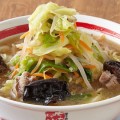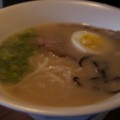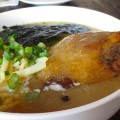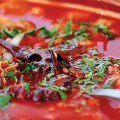A throng of people snakes around the interior of the Valley Fair Mall, waiting in a line that’s well-over over 90 minutes long. What could they possibly be waiting for? A celebrity autograph? The latest gadget from Apple? The answer, as it turns out, is ramen.
The brainchild of Satoshi Ikuta, the award-winning Ramen Nagi recently opened its second US location in the Santa Clara shopping center.
Ikuta, the son of a gas worker and a nurse, never had aspirations of becoming a famous chef. However, as a young man, he fell in love with the high-intensity, team-driven nature of kitchen work—and after a visit to New York a year after 9/11, he was inspired to strike out on his own.
“Even after a crisis like that, I saw that people were making good food from all over, and I wanted to join in,” Ikuta says, through a translator. “And not just in Japan, but all over the world.”
Upon returning home he realized he didn’t have the money to start his own business. So he began the practice of aida kari, borrowing space at a small food station in the bustling Hakata-ku ward of Fukuoka, Japan. It was here that he began honing his craft and developing his signature flavors.
“I got a lot of feedback while running my bar from customers,” he says. “They would say I want the chashu (roast pork) bigger, or I want my soup thicker.”
Ikuta listened. Soon his adjustments and hard work led to a big win in a Tokyo ramen contest, which won him a spot in Tokyo’s famed Tachikawa Ramen Square noodle theme park. He opened his first restaurant in 2004 at the age of 27. Ikuta now has 35 restaurants all over the world, but his sole American storefronts are located here in Silicon Valley.
He opened his first U.S. location in Palo Alto last June; the Valley Fair restaurant opened in December. South Bay ramen fans have definitely taken notice, as both restaurants sport a 4.5-star average on Yelp, and Nagi took second in the 2019 Metro “Best of Silicon Valley” reader’s poll; the Michelin Plate-rated Orenchi Ramen took first.
Nagi’s known for their Hakata-style ramen, which is renowned for being served quickly and simply. Their standard ramen, dubbed the “original king,” features a rich, 20-hour slow-simmered tonkotsu (pork bone) broth, noodles that are made daily in-house, and a few slices of melt-in-mouth chashu.
This simple base provides a great platform for building out flavors, as Nagi has branched out to include a squid ink, pesto and a spicy chili ramen, aptly named the black, green and red kings, respectively. Ikuta has also developed a vegetarian ramen (veggie king), specifically for the US market. It includes a puréed, roasted cauliflower base, shiitake mushrooms and a potato hashbrown “chashu” cutlet that was inspired by Ikuta’s visits to American diners. He is currently working on developing a vegan broth, as the veggie king does include milk in its base.
Patrons may also expand on those five options. Spice level, the amount of flavoring oil used and even the texture of the noodles (soft, medium or firm) can be customized.
Ordering sheets are handed out to hungry customers while they wait in line, so that by the time they are seated, their orders are being processed.
“When working in Hong Kong, I quickly realized that my lack of English skills was going to be an issue,” Ikuta says. “So I developed this ordering sheet to help bridge that language barrier.”
The word “nagi” means calm, but the restaurant itself is anything but serene. A swarm of well-trained staff buzz around in red shirts and yellow bandannas, delivering food and making sure diner’s needs are met, while a mix of Japanese heavy metal and pop songs pulsates over the restaurant’s sound system. The goal is to get patrons seated, fed and on their way as quickly as possible—another hallmark of Hakata ramen bars. While this may sound a bit harried, I never felt rushed. It was more like a well-organized dance routine.
The ramen itself is spectacular. The pork broth is rich and has just the right balance of unctuous porky flavor, salt and a milky creaminess. They are also generous with the noodles. Hakata ramen is known for its thin noodles, which can be cooked quickly, but Nagi has a thicker option for a more robust noodle experience.
After I had finished my interview and meal, I began to walk back to my car when I was surprised to see Ikuta chase me down with his translator. He seemed genuinely interested in whether I had enjoyed my ramen. I noticed that the line was still going strong, though I had been there for at least two hours. I asked him what he thinks when he sees that many people waiting for so long to eat his ramen.
“When I first opened up my shops, I was lucky to have two or three people a day,” he said, his eyes lighting up and his smile widening. “And now—this is unbelievable. Because I started from nothing and I fear that could still happen. So I am very thankful.”
Ramen Nagi
2855 Stevens Creek Blvd, Ste 2333, Santa Clara
541 Bryant St, Palo Alto
ramennagiusa.com

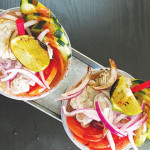 Loaded Micheladas and Enchis at Bravo! House of Enchiladas
Loaded Micheladas and Enchis at Bravo! House of Enchiladas  Forks & Knives: San Jose's Own Whiskey Distillery and Boozy Taco Bell
Forks & Knives: San Jose's Own Whiskey Distillery and Boozy Taco Bell 